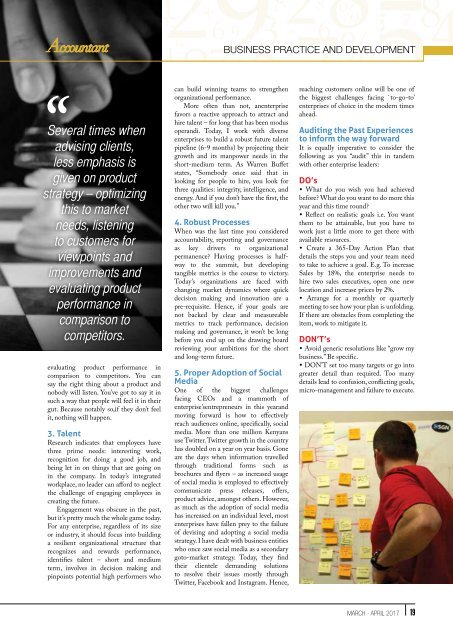The Accountant-Mar-April 2017
You also want an ePaper? Increase the reach of your titles
YUMPU automatically turns print PDFs into web optimized ePapers that Google loves.
Business Practice and Development<br />
Several times when<br />
advising clients,<br />
less emphasis is<br />
given on product<br />
strategy – optimizing<br />
this to market<br />
needs, listening<br />
to customers for<br />
viewpoints and<br />
improvements and<br />
evaluating product<br />
performance in<br />
comparison to<br />
competitors.<br />
evaluating product performance in<br />
comparison to competitors. You can<br />
say the right thing about a product and<br />
nobody will listen. You’ve got to say it in<br />
such a way that people will feel it in their<br />
gut. Because notably so,if they don’t feel<br />
it, nothing will happen.<br />
3. Talent<br />
Research indicates that employees have<br />
three prime needs: interesting work,<br />
recognition for doing a good job, and<br />
being let in on things that are going on<br />
in the company. In today’s integrated<br />
workplace, no leader can afford to neglect<br />
the challenge of engaging employees in<br />
creating the future.<br />
Engagement was obscure in the past,<br />
but it’s pretty much the whole game today.<br />
For any enterprise, regardless of its size<br />
or industry, it should focus into building<br />
a resilient organizational structure that<br />
recognizes and rewards performance,<br />
identifies talent – short and medium<br />
term, involves in decision making and<br />
pinpoints potential high performers who<br />
can build winning teams to strengthen<br />
organizational performance.<br />
More often than not, anenterprise<br />
favors a reactive approach to attract and<br />
hire talent – for long that has been modus<br />
operandi. Today, I work with diverse<br />
enterprises to build a robust future talent<br />
pipeline (6-9 months) by projecting their<br />
growth and its manpower needs in the<br />
short-medium term. As Warren Buffet<br />
states, “Somebody once said that in<br />
looking for people to hire, you look for<br />
three qualities: integrity, intelligence, and<br />
energy. And if you don’t have the first, the<br />
other two will kill you.”<br />
4. Robust Processes<br />
When was the last time you considered<br />
accountability, reporting and governance<br />
as key drivers to organizational<br />
permanence? Having processes is halfway<br />
to the summit, but developing<br />
tangible metrics is the course to victory.<br />
Today’s organizations are faced with<br />
changing market dynamics where quick<br />
decision making and innovation are a<br />
pre-requisite. Hence, if your goals are<br />
not backed by clear and measureable<br />
metrics to track performance, decision<br />
making and governance, it won’t be long<br />
before you end up on the drawing board<br />
reviewing your ambitions for the short<br />
and long-term future.<br />
5. Proper Adoption of Social<br />
Media<br />
One of the biggest challenges<br />
facing CEOs and a mammoth of<br />
enterprise’sentrepreneurs in this yearand<br />
moving forward is how to effectively<br />
reach audiences online, specifically, social<br />
media. More than one million Kenyans<br />
use Twitter. Twitter growth in the country<br />
has doubled on a year on year basis. Gone<br />
are the days when information travelled<br />
through traditional forms such as<br />
brochures and flyers – as increased usage<br />
of social media is employed to effectively<br />
communicate press releases, offers,<br />
product advice, amongst others. However,<br />
as much as the adoption of social media<br />
has increased on an individual level, most<br />
enterprises have fallen prey to the failure<br />
of devising and adopting a social media<br />
strategy. I have dealt with business entities<br />
who once saw social media as a secondary<br />
goto-market strategy. Today, they find<br />
their clientele demanding solutions<br />
to resolve their issues mostly through<br />
Twitter, Facebook and Instagram. Hence,<br />
reaching customers online will be one of<br />
the biggest challenges facing `to-go-to’<br />
enterprises of choice in the modern times<br />
ahead.<br />
Auditing the Past Experiences<br />
to inform the way forward<br />
It is equally imperative to consider the<br />
following as you “audit” this in tandem<br />
with other enterprise leaders:<br />
DO’s<br />
• What do you wish you had achieved<br />
before? What do you want to do more this<br />
year and this time round?<br />
• Reflect on realistic goals i.e. You want<br />
them to be attainable, but you have to<br />
work just a little more to get there with<br />
available resources.<br />
• Create a 365-Day Action Plan that<br />
details the steps you and your team need<br />
to take to achieve a goal. E.g. To increase<br />
Sales by 18%, the enterprise needs to<br />
hire two sales executives, open one new<br />
location and increase prices by 2%.<br />
• Arrange for a monthly or quarterly<br />
meeting to see how your plan is unfolding.<br />
If there are obstacles from completing the<br />
item, work to mitigate it.<br />
DON’T’s<br />
• Avoid generic resolutions like “grow my<br />
business.” Be specific.<br />
• DON’T set too many targets or go into<br />
greater detail than required. Too many<br />
details lead to confusion, conflicting goals,<br />
micro-management and failure to execute.<br />
MARCH - ApRIL <strong>2017</strong> 19

















